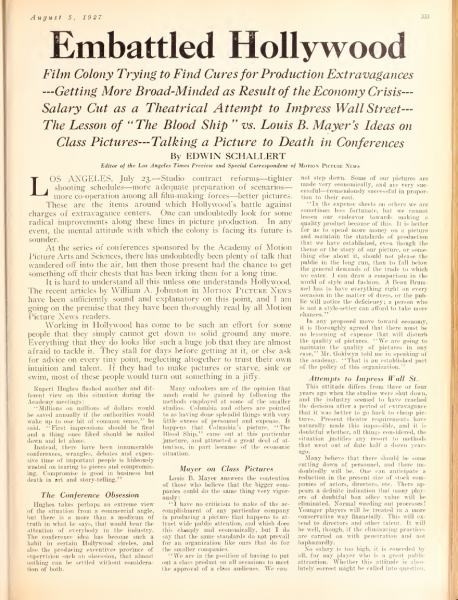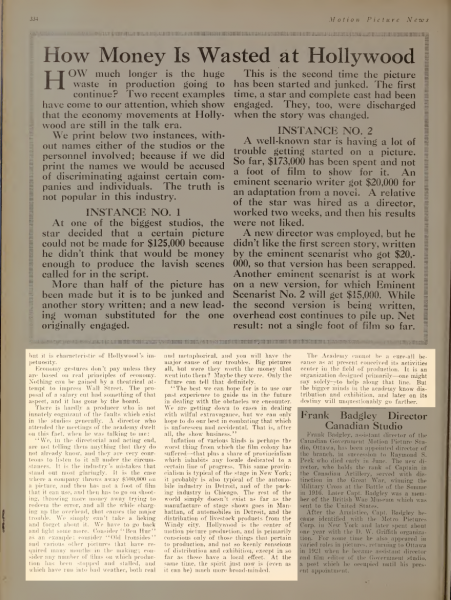| Artifact Type | Sources, Trade Journals |
| Publication | Motion Picture News |
| Volume | 36 |
| Page Number | 333–334 |
| Place | New York, NY |
| Publication Date | August 5, 1927 |
| Transcript | Show/Hide |
|
Headline: “Embattled Hollywood” Subhead: Film Colony Trying to Find Cures for Production Extravagances — Getting More Broad-Minded as Result of the Economy Crisis — Salary Cut as a Theatrical Attempt to Impress Wall Street — The Lesson of “The Blood Ship” vs. Louis B. Mayer’s Ideas on Class Pictures — Talking a Picture to Death in Conferences LOS ANGELES, July 23. — Studio contract reforms — tighter shooting schedules — more adequate preparation of scenarios — more co-operation among all film-making forces — better pictures. These are the items around which Hollywood’s battle against charges of extravagance centers. One can undoubtedly look for some radical improvements along these lines in picture production. In any event, the mental attitude with which the colony is facing its future is sounder. At the series of conferences sponsored by the Academy of Motion Picture Arts and Sciences, there has undoubtedly been plenty of talk that wandered off into the air, but then those present had the chance to get something off their chests that has been irking them for a long time. It is hard to understand all this unless one understands Hollywood. The recent articles by William A. Johnston in Motion Picture News have been sufficiently sound and explanatory on this point, and I am going on the premise that they have been thoroughly read by all Motion Picture News readers. Working in Hollywood has come to be such an effort for some people that they simply cannot get down to solid ground any more. Everything that they do looks like such a huge job that they are almost afraid to tackle it. They stall for days before getting at it, or else ask for advice on every tiny point, neglecting altogether to trust their own intuition and talent. If they had to make pictures or starve, sink or swim, most of these people would turn out something in a jiffy. Rupert Hughes flashed another and different view on this situation during the Academy meetings: “Millions on millions of dollars would be saved annually if the authorities would wake up to one bit of common sense,” he said. “First impressions should be final and a thing once liked should be nailed down and let alone. Instead, there have been innumerable conferences, wrangles, debates and expensive time of important people is hideously wasted on tearing to pieces and compromising. Compromise is good in business but death in art and story-telling.” The Conference Obsession Hughes takes perhaps an extreme view of the situation from a commercial angle, but there is a more than a modicum of truth in what he says, that would bear the attention of everybody in the industry. The conference idea has become such a habit in certain Hollywood circles, and also the producing executives province of supervision such an obsession, that almost nothing can be settled without consideration of both. Many onlookers are of the opinion that much could be gained by following the methods employed at some of the smaller studios. Columbia and others are pointed to as having done splendid things with very little excess of personnel and expense. It happens that Columbia’s picture, “The Blood Ship,” came out at this particular juncture, and attracted a great deal of attention, in part because of the economic situation. Mayer on Class Pictures Louis B. Mayer answers the contention of those who believe that the bigger companies could do the same thing very vigorously: “I have no criticism to make of the accomplishment of any particular company in producing a picture that happens to attract wide public attention, and which does this cheaply and economically, but I do say that the same standards do npt prevail for an organization like ours that do for the smaller companies. “We are in the position of having to put out a class product on all occasions to meet the approval of a class audience. We cannot step down. Some of our pictures are made very economically, and are very successful—tremendously successful in proportion to their cost. “In the expense sheets on others we are sometimes less fortunate, but we cannot lessen our endeavor towards making a quality product because of this. It is better for us to spend more money on a picture and maintain the standards of production that we have established, even though the theme or the story of our picture, or something else about it, should not please the public in the long run, than to fall below the general demands of the trade to which we cater. I can draw a comparison in the world of style and fashion. A Beau Brummel has to have everything right on every occasion in the matter of dress, or the public will notice the deficiency; a person who is not a style-setter can afford to take more chances.” In any proposed move toward economy, it is thoroughly agreed that there must be no lessening of expense that will disturb the quality of pictures. “We are going to maintain the quality of pictures in any case,” Mr. Goldwyn told me in speaking of the academy. “That is an established part of the policy of this organization.” Attempts to Impress Wall St. This attitude differs from three or four years ago when the studios were shut down, and the industry seemed to have reached the decision after a period of extravagance that it was better to go back to cheap pictures. Present theatre requirements have naturally made this impossible, and it is doubtful whether, all things considered, the situation justifies any resort to methods that went out of date half a dozen years ago. Many believe that there should be some cutting down of personnel, and there undoubtedly will be. One can anticipate a reduction in the present size of stock companies of actors, directors, etc. There appears a definite indication that many players of doubtful box office value will be eliminated. Normal weeding out processes! Younger players will be treated in a more conservative way financially. This will extend to directors and other talent. It will be well, though, if the eliminating practices are carried on with penetration and not haphazardly. No salary is too high, it is conceded by all, for any player who is a great public attraction. Whether this attitude is absolutely correct might be called into question, but it is characteristic of Hollywood’s impetuosity. Economy gestures don’t pay unless they are based on real principles of economy. Nothing can be gained by a theatrical attempt to impress Wall Street. The proposal of a salary cut had something of that aspect, and it has gone by the board. There is hardly a producer who is not innately cognizant of the faults which exist in the studios generally. A director who attended the meetings of the academy dwelt on this fact, when he was talking to me: “We, in the directorial and acting end, are not telling them anything that they do not already know, and they are very courteous to listen to it all under the circumstances. It is the industry’s mistakes that stand out most glaringly. It is the case where a company throws away $500,000 on a picture, and then has not a foot of film that it can use, and then has to go on shooting, throwing more money away trying to redeem the error, and all the while charging up the overhead, that causes the major trouble. We simply can’t take a licking and forget about it. We have to go back and fight some more. Consider “Ben Hur” as an example; consider “Old Ironsides” and various other pictures that have recquired many months in the making; consider any number of films on which production has been stopped and stalled, and which have run into bad weather, both real and metaphorical, and you will have the major cause of our troubles. Big pictures all, but were they worth the money that went into them? Maybe they were. Only the future can tell that definitely. “The best we can hope for is to use our past experience to guide us in the future in dealing with the obstacles we encounter. We are getting down to cases in dealing with wilful extravagance, but we can only hope to do our best in combating that which is unforeseen and accidental. That is, after all, the show business.” Inflation of various kinds is perhaps the worst thing from which the film colony has suffered — that this a share of provincialism which inhabits any locale dedicated to a certain line of progress. This same provincialism is typical of the stage in New York; it probably is also typical of the automobile industry in Detroit, and of the packing industry in Chicago. The rest of the world simply doesn’t exist as far as the manufacture of stage shows goes in Manhattan, of automobiles in Detroit, and the distribution of livestock products from the Windy city. Hollywood is the center of motion picture production, and is primarily conscious only of those things that pertain to production, and not so keenly conscious of distributicm and exhibition, except in so far as these have a local effect. At the same time, the spirit just now is (even as it can be) much more broad-minded. The Academy cannot be a cure-all because as at present conceived its activities center in the field of production. It is an organization designed primarily — one might say solely to help along that line. But the bigger minds in the academy know distribution and exhibition, and later on its destiny will unquestionably go farther. |
|
| Archive | The Internet Archive |
| Read In Context | http://archive.org/stream/motion36moti#page/333/mode/2up |
| Citation | Edwin Schallert, “Embattled Hollywood,” Motion Picture News, August 5, 1927. |
| Tags | 1920s1927August 1927 |

